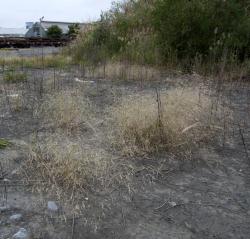- Taxon
- Gallery
- ≡ Avena filiformis G.Forst., Fl. Ins. Austr. 9 (1786)
- ≡ Agrostis filiformis (G.Forst.)Spreng (1807)
- ≡ Calamagrostis filiformis (G.Forst.) Cockayne, Rep. Bot. Survey Tongariro Natl. Park 35 (1908)
- ≡ Deyeuxia filiformis (G.Forst.) Petrie, Subantarctic Is. N. Z., 474 (1909)
- = Agrostis avenacea J.F.Gmel. (1791)
- ≡ Lachnagrostis avenacea (J.F.Gmel.) Veldkamp, Blumea 37: 230 (1992)
- = Agrostis forsteri Roem. & Schult., Syst. Veg. 359 (1817)
- ≡ Lachnagrostis forsteri (Roem. & Schult.) Trin. (1824) nom. nov.
- ≡ Deyeuxia forsteri (Roem. & Schult.) Kunth (1829)
- = Agrostis solandri F.Muell., Veg. Chatham Isl. 60 (1864)
Open, bluish green or light green, annual or short-lived perennial tufts, (12)–20–70 cm, whole plant often withering early and culms not breaking up below panicle; branching intravaginal. Leaf-sheath firmly membranous, distinctly ribbed, glabrous below, very finely scabrid above, light green, later light brown. Ligule (1)–2–5 mm, oblong, rounded or tapered, later lacerate, abaxially with sparse prickle-teeth. Leaf-blade 2.5–8–(18) cm × 1.5–3 mm, usually flat, sometimes involute and 0.5–1 mm diam., glabrous, or ribs scabrid; margins very finely scabrid, tip fine, acute. Culm 10–35 cm, erect to spreading, internodes usually densely, minutely scabrid, occasionally smooth. Panicle 9–30 × (0.5)–2–25 cm, delicate, enclosed at base by the uppermost leaf-sheath, at first contracted, later very lax; branches filiform, numerous, unequal, very finely scabrid, primary branches naked for much of their length, with spikelets in clusters of 2-several, towards tips of the much shorter capillary secondary branchlets. Spikelets 2.5–3.5–(4.2) mm, pale silvery green to purplish. Glumes subequal, acute to acuminate, usually glabrous, membranous, very narrow linear-lanceolate, lower glume usually slightly longer and more acuminate; keel scabrid almost to base. Lemma 1.3–2–(2.3) mm, ½-⅔ length of glumes, 5-nerved, moderately covered with very short hairs, oblong-ovate, glabrous near hyaline, truncate, erose apex, lateral nerves very shortly excurrent; awn 3–6 mm, geniculate, ± middorsal or from c. upper ⅓. Palea ¾-⅘ length of lemma, keels c. 0.1 mm apart, apex subobtuse. Callus ringed by minute hairs 0.3–0.4 mm, to ¼ length of lemma. Rachilla prolongation 0, or to c. 0.3 mm tipped with hairs to c. 0.8 mm. Lodicules 0.5–0.9 mm, linear, acute. Anthers 0.2–0.5 mm. Caryopsis 0.8–1.3 × 0.3–0.5 mm.
[From: Edgar and Connor (2000) Flora of New Zealand. Volume 5 (second printing).]




